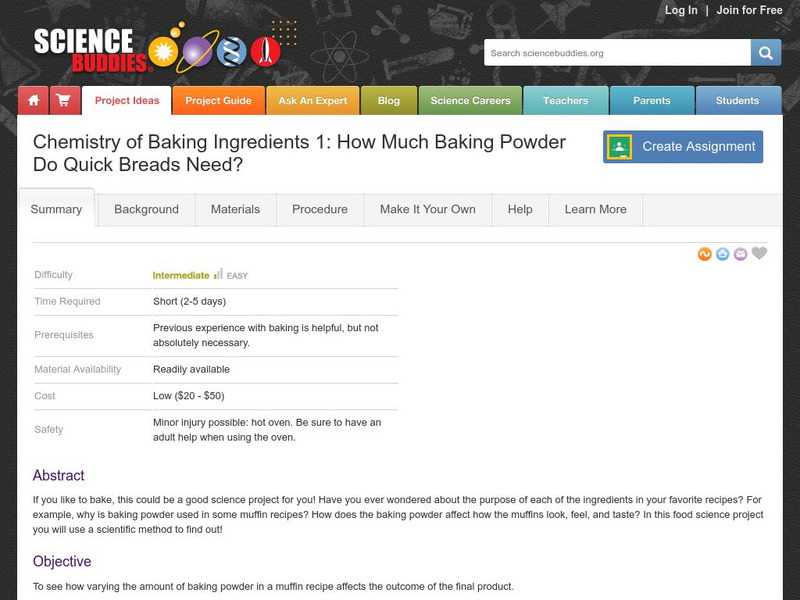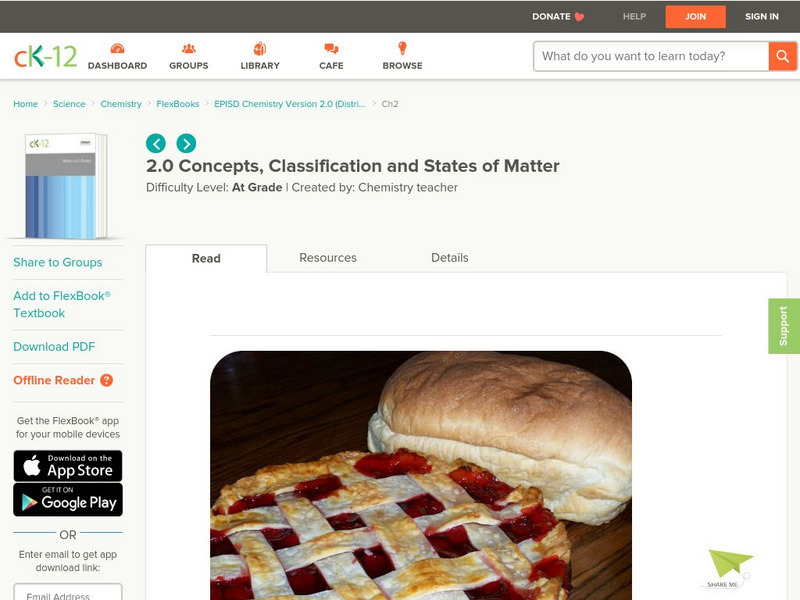Hi, what do you want to do?
Curated OER
M&M Cookie Math
Students munch their way through a cookie keeping a tally of how many M&M's are found of each color.
Curated OER
Celebrate Maine Cooking!
Students examine and analyze different Maine recipes. After analyzing the recipes, students work in groups to determine what characteristics the recipes posses for it to be chosen to represent the culture of Maine. Students bring in...
Curated OER
Pies: A Practical Application
Students participate in making a pie. They are to discuss the nutritional value and the different types of pies. They also answer questions from the teacher about fat and they complete a pie evaluation form.
Curated OER
Chocolate Asphalt Cookies
Young scholars investigate basic engineering principles, road construction and material science through a unique and fun hands-on activity.
Curated OER
Our Food and Microorganisms
Students answer questions about how microorganisms can affect our food supply and how they can be controlled. The first set of inquiry activities are directed by the teacher. Subsequent activities are based on students generating their...
Curated OER
Farming: Raising Winter Wheat (Lesson 3)
Students identify foods that are made from wheat. They use a line graph to explain measurement. They identify foods from the food groups and explain how temperature, prefcipitation and natural resources affect the growth of wheat.
Curated OER
Let's Make Bread!
Pupils participate in making bread. They are required to follow the recipe and directions given to them by the teacher. A field trip to the grocery store can also be included.
Curated OER
Yeast Breads - Indian Fry Bread Taco
Students use Rhodes frozen dough, a convenience product, to prepare another class of yeast breads as they deep-fat fry the thawed dough and individually prepare Indian Fry Bread Tacos. They apply the principles they have learned in...
Curated OER
Australian Anzac Biscuits
In this Australian worksheet, students, after studying and researching the history to Australia, create a recipe for Australian Anzac Biscuits.
Curated OER
Make an Edible Coral Reef
Students create an edible coral reef out of food and candy. In this Science lesson, students explore what a coral reef is and the coral reef's importance to the ecosystem. Additionally, students discover the different parts of a...
Curated OER
Couch Potatoes Around the World#138
Students identify potato chips as a consumer product and investigate what processes are needed to make the chips. They investigate where the potatoes are grown and harvested before being made into chips at a processing plant. They make a...
Science Buddies
Science Buddies: How Much Baking Powder Do Quick Breads Need?
If you like to bake, this could be a good project for you. There is a purpose for each of the ingredients in your recipes, but not everyone is always aware of what that purpose may be. Though this lab takes multiple days, you will...
Science Buddies
Science Buddies: Can Baking Soda Substitute for Baking Powder in a Recipe?
There's nothing quite like the smell of fresh-baked muffins for breakfast on a Saturday morning. If you're into baking, you might want to try this insightful project that lets you witness the chemistry behind making muffins. You'll get...
American Chemical Society
American Chemical Society: Development of Baking Powder
The invention of baking powder had a huge impact on bakers' ability to produce and distribute bread to large numbers of people. The history of this lowly ingredient is presented, along with a chemistry lesson plan for secondary students.
American Chemical Society
Inquiry in Action: Exploring Baking Powder
An activity that allows students to discover the active ingredients in baking powder by studying chemical change. Lab activity includes both teacher and student instructions.
Illustrative Mathematics
Illustrative Mathematics: 6.ns Baking Cookies
Sixth graders are asked to do arithmetic with fractions in order to calculate the amount of ingredients they have for baking cookies and how many batches they can make. Aligns with 6.NS.A.1.
Other
Cooking With Kids: Breakfast Baked in a Bar
Here is a simple recipe for kids to try with their parents' help. Learn to make breakfast bars using crescent rolls, apples, walnuts, caramels and common ingredients that are probably already in your kitchen.
Science Buddies
Science Buddies: How Do You Make the 'Best' Cookie?
The benefit to cooking food from scratch versus store bought food is that you determine the taste. In this science fair project, discover if you can perfect the taste of your favorite cookie right in your own kitchen by experimenting...
Maryland Science Center
Maryland Science Center: Bubbling Cauldron Dough [Pdf]
Create a dough using simple ingredients and make it bubble like a brew in a cauldron by causing an acid-base reaction.
A&E Television
History.com: History This Week: The Mother of Level Measurements
September 24, 1902. A new cooking school is set to open at Boston's 30 Huntington Avenue. The rooms will soon be filled with trainee cooks, who will watch in awe as the school's namesake and principal, Fannie Farmer, lectures on...
ClassFlow
Class Flow: Healthy Eating Activity 3: Composite Dishes
[Free Registration/Login Required] This flipchart supports lessons from the Food - a fact of life website. Pupils will be able to identify a healthy meal working out what are the key ingredients for the meals presented.
CK-12 Foundation
Ck 12: Concepts, Classification and States of Matter
[Free Registration/Login may be required to access all resource tools.] Freshly baked bread and cherry pie are two delicious parts of any meal. What happens to the ingredients that go into the bread and the pie as they are heated in the...























![Maryland Science Center: Bubbling Cauldron Dough [Pdf] Activity Maryland Science Center: Bubbling Cauldron Dough [Pdf] Activity](https://static.lp.lexp.cloud/images/attachment_defaults/resource/large/FPO-knovation.png)

